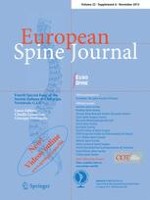Erschienen in:

01.11.2013 | Original Article
Do benefits overcome the risks related to surgery for adult scoliosis? A detailed analysis of a consecutive case series
verfasst von:
Giovanni Barbanti Bròdano, Silvia Terzi, Alessandro Gasbarrini, Stefano Bandiera, Christiano Simoes, Stefano Boriani
Erschienen in:
European Spine Journal
|
Sonderheft 6/2013
Einloggen, um Zugang zu erhalten
Abstract
Purpose
The surgical approach to adult spine deformities is complex and presents a high incidence of complications.
Methods
We report here a prospective consecutive case series analysis of 20 patients submitted to posterior correction and instrumented fusion for adult degenerative scoliosis. Clinical outcomes were assessed by self-reported measures. Pre-operative and post-operative complications were analysed during a mean 30-month follow-up period.
Results
Eleven patients (55 %) presented pre-operative or post-operative complications. Fifteen different complications occurred, six in the early pre-operative period and nine during follow-up period: ten of these complications occurred in patients who underwent a previous surgery for spine disease.
Conclusions
The clinical improvement at the final follow-up resulted as statistically significant only for the group of patients exposed to posterior fusion without interbody fusion. The observations reported here have to be considered for a shared decision-making in the management of adult scoliosis.